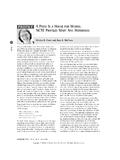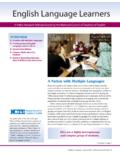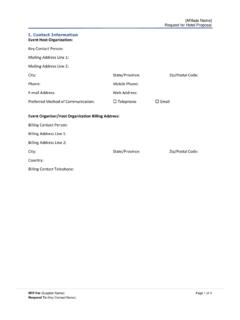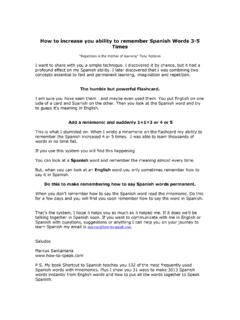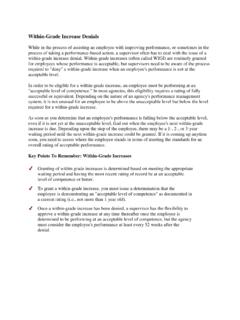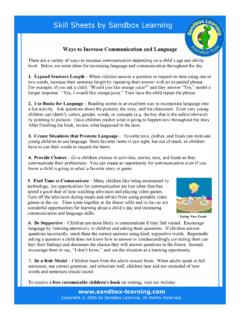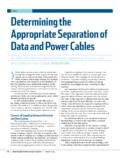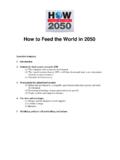Transcription of 16 How Can Teachers Increase Classroom Use of Academic ...
1 Larson, Dixon, and Townsend | How Can Teachers Increase Classroom Use of Academic Vocabulary?page16 Voices from the Middle, Volume 20 Number 4, May 2013 Lisa Larson, Temoca Dixon, and Dianna TownsendHow Can Teachers Increase Classroom Use of Academic Vocabulary?My seventh-grade students are in their seats, shifting their gazes between the large poster paper hanging on the white board, the colored markers in my hand, and the tim-er. The prefix re- is written on top of the page. As soon as I give my class the signal, hands shoot into the air, calling out words such as rewrite, repost, redraw, reform during a collective 10-minute brainstorm. Students suggest words and I add them to the growing list, if they properly use the prefix. At the end of 10 minutes, we count our words; it is a great list.
2 At this point, I explain, Once you learned the prefix re-, you packed your word bank. (See Fig 1.) Then I flip through the posters from other classes and point out, Yet, you still did not think of all the words other classes found. Once you understand word parts, you have access to an in-credible number of words. My students argued, Ms. Dixon, why are we learning vocabulary in social studies? I watched as my students looked at each of the lists, the class word wall, and back at me. I saw them realize what I had been trying to explain: active vocabulary practice is invalu-able to their Academic success. Why? Because ac-tive vocabulary practice helps young adolescent learners develop Academic language and access Academic social studies Teachers , one teaching in a rural middle school and one teaching in an ur-ban middle school, we value rich vocabulary in-struction (Beck, McKeown, & Kucan, 2002, p.)
3 108). Given that our students are encountering increasingly Academic texts in our classrooms, this type of instruction is exactly what they need in order to access those texts. Our students repre-sent typical rural and urban populations from low socioeconomic backgrounds, and we see national achievement trends for these groups playing out in our classrooms. Since the National Assessment for Educational Progress (NAEP) began measur-ing reading achievement in 1992, the nation s fourth and eighth graders have shown little to no growth ( Department of Education, 2007). Recently, our state adopted the Common Core State Standards (CCSS), developed by the Na-tional Governors Association Center for Best Practices, Council of Chief State School Officers. CCSS promises to Increase the rigors of reading.
4 With the evidence that students have difficulty with Academic language, the new standards have the potential to further amplify the literacy critical component to Academic reading comprehension is understanding the vocabulary, Figure 1. Example of a morphology brainstorming 163/30/13 10:54 AMpage17 Voices from the Middle, Volume 20 Number 4, May 2013 Larson, Dixon, and Townsend | How Can Teachers Increase Classroom Use of Academic Vocabulary?and gaps in vocabulary knowledge are a factor for low reading achievement (Harmon, Hed-rick, & Wood, 2006; Kelley, Lesaux, Kieffer, & Faller, 2010; Lesaux, Kieffer, Faller, & Kelley, 2010). In order to make sense of increasingly dense Academic texts, middle-level students must possess strategies to understand and use words, which will, with other types of text-based sup-port, Increase comprehension.
5 For these reasons, Academic vocabulary has received a great deal of attention in both the research and practitioner literature (see Baumann & Graves, 2010, for an overview). However, for our purposes, it is the definition provided by Flynt and Brozo (2008) that is most applicable to the Classroom ; aca-demic vocabulary is word knowledge that makes it possible for students to engage with, produce, and talk about texts that are valued in school (p. 500). What Is Effective Academic Vocabulary Instruction?As part of an action research project, we exam-ined and supplemented our practice for helping our students build Academic vocabulary knowl-edge. Our research question for the project was based on Blachowicz and Fisher s (2000) asser-tion that students should be responsible for tak-ing an active role in learning new vocabulary words.
6 Active engagement means learning the meaning of specific words (where it is important to make connections between and among words and concepts), and learning strategies to become independent word learners (p. 505). There-fore, our purpose for this project was to answer the question: How can we enhance young ado-lescents active engagement with Academic vo-cabulary while engaging with texts in our social studies classes?To start, we built a common understanding of Academic vocabulary words, considering both general Academic words and content-specific words. For general Academic word knowledge, we relied on Coxhead s (2000) work. She created a list of 560 Academic vocabulary word families consisting of thousands of terms students would most likely see across content areas.
7 However, this list was never intended as a prescriptive list of words to teach, and we did not use it that way. Rather, we used the list as a guide for the type of word we wanted to attend to as we encountered them in the texts we were reading. For ex-ample, proceed, a word from the list, can mean to move forward, and proceeds can indicate the money received from an economic ven-ture. Different forms of this word can be found in many other content areas, often with varying meanings. In science, students must follow lab procedures, and in math, solving equations requires a specific process. In social studies, students can read about a funeral procession. The discussion of words at this basic but interconnected level is important to the deeper learning of words and supports the prin-ciple of active engagement.
8 As we encountered general Academic words in our instructional texts with our students, we would stop to run short pair-shares or whole-class discussions on how these words are used in various Academic Vocabulary Practice in Social Studies ClassroomsThe following are strategies from our action re-search project that we found to be the most effec-tive in engaging middle-level students in building Academic vocabulary knowledge and increasing access to Academic Walls Word walls provide visual support for all learn-ers in their acquisition of Academic vocabulary. Corson (1997) tells us that words are only fully learned when they are available for active use (p. 699). We learned that it is important when creat-ing a word wall that the words are terms students In order to make sense of increasingly dense Academic texts, middle-level students must possess strategies to understand and use words, which will, with other types of text-based support, in-crease 173/30/13 10:54 AMLarson, Dixon, and Townsend | How Can Teachers Increase Classroom Use of Academic Vocabulary?
9 Page18 Voices from the Middle, Volume 20 Number 4, May 2013 Morphology, the study of word structure, including roots, bases, and affixes, is an extremely powerful tool for building Academic language created and manipulated, not simply words up for display (Fisher & Frey, 2008). The orga-nization of word walls varies; some walls arrange terms in alphabetical order, some use common themes or units of study (Fisher & Frey, 2008; Yates, Cuthrell, & Rose, 2011). In creating our word walls, we engaged stu-dents in decisions about the placement of the words according to Beck, McKeown, and Kucan s (2002) tiers (see Fig. 2). Our students were al-ready comfortable with these categories from our previous work together. Tier 1 words are basic, everyday vocabulary; Tier 2 words are similar to general Academic words; and Tier 3 words equate with content-specific words.
10 The discussions about where words be-longed provided students with the opportunity to deepen their ownership of the words. We also found that simple prompts for entry and exit slips were time-efficient ways to help students pay at-tention to and use word wall words. Examples of entry slip prompts are: Write down the words _____, _____, and _____ from our word wall and, with a part-ner, write down everything you think you know about them. Here are two questions we ll be answering today: Which word wall words do you think will be most important in today s lesson? Why?Examples of exit slip prompts are: Write down one new thing you learned today and use at least two of our word wall words in your response. Look around at our word walls. Which words were the most important from today s lesson?

